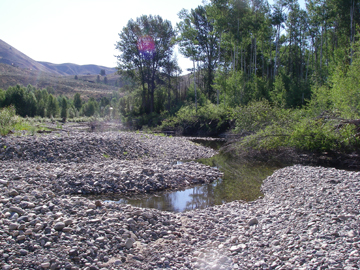Scientists at US Geological Survey's Western Fisheries Research Center recently published the results of a four-year study (2009-2012) about the contribution of three types of side channels based on their hydrological connectivity (seasonally disconnected, partially connected, and fully connected) to production of juvenile anadromous salmonids. The objective of the study was to assess existing fish populations in and fish use of side channels of the Methow River as a prelude to stream restoration targeting enhanced side channel connectivity.
| Juvenile Chinook densities were higher in side channels than in both tributary and mainstem lateral habitats. Densities of juvenile steelhead in side channels were similar to those in tributary habitats, and both tributaries and side channels had higher densities than mainstem lateral habitats.
Juvenile steelhead (Oncorhynchus mykiss) and Chinook salmon (O. tshawytscha) were found in all side channel types and in each year of the study, and there were no differences between the densities and mean number of smolts produced per linear meter for juvenile steelhead and Chinook among the three types of side channels.
|  360.jpg) |
| | Side channel habitat in the Methow Basin - photo by USGS |
 | Coho salmon (currently being reintroduced in the Methow River) were present sporadically in partially and fully connected side channels. In seasonally disconnected side channels, however, the mean number of coho smolts produced per meter (0.0592 smolt/m) was over seven times that of steelhead and Chinook. Within seasonally disconnected side channels, juvenile salmonids in deep pools (> 100 cm) had higher survival than those in shallow pools (< 100 cm). During high flows, as disconnected side channels became reconnected with the mainstem, the previous year's cohort of juvenile salmon emptied out of the side channel. At the same time, the re-connected side channel filled up with young-of-year salmonid. |
| Side channel habitat in the Methow Basin - photo by USGS | |
| The authors concluded that improving quality of pool habitat within disconnected side channels is likely to result in improved juvenile salmonid survival. Habitat improvement in these disconnected side channels should be recognized as a possible restoration strategy, especially when full connectivity of side channels may not be a feasible target (e.g., when too little water is available) or when reconnection is too high of risk (e.g., because of flooding, stream capture, or bank destabilization). |  360.jpg)
Side channel habitat in the Methow River Basin - photo by USGS |